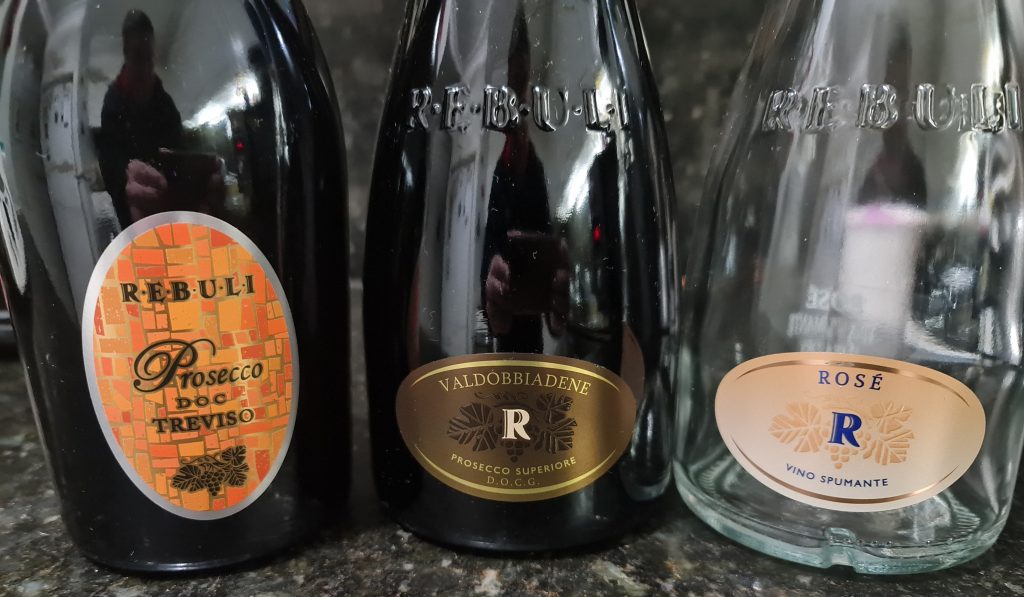
Did you know that Prosecco is the main ingredient in Aperol Spritz? But what is Prosecco?
Prosecco is a type of sparkling wine from Italy made with the Glera grape. It’s produced in nine provinces in the Veneto and Friuli Venezia Giulia regions of north eastern Italy, close to the border with Austria and Slovenia. Most Prosecco is produced using a process called the Charmat method (or Martinotti method in Italy), where the still base wine is placed in a stainless steels tank before yeast and sugar is added to start the secondary fermentation which creates the bubbles. The time spent in the tank also allows the wine to stay in contact with the dead yeast cells (called lees), which adds complexity to the wine. The longer the amount of time the wine spends on lees, the more complexity it gains.
To be called Prosecco, it must be certified to come from the designated area denoted with the words “DOC” or “DOCG” which must also appear on its label. The requirements for DOC and DOCG Prosecco are slightly different, although both wines must contain the Glera grape.
Denominazione di Origine Controllata or DOC can be applied to any wine from the nominated region that conforms to the governing bodies requirements including:
- Minimum 85% Glera grapes;
- Use of the Charmat–Martinotti method that carries out the secondary fermentation in stainless steel tanks;
- Minimum production time of 30 days which normally means a minimum of 30 days in the stainless steel tanks although most producers leave it longer;
- It can be full sparkling (spumante) or semi-sparkling (Frizzante);
- It can come in range of sweetness levels from Brut (less than 12g/L of residual sugar) to Extra Dry (12-17 g/L) to Dry (17/32g/L)
The grapes for DOC Prosecco often come from flat areas of land or in the foothills, where higher yields of grapes and shorter production times make less complex, fruity sparkling wines.
Denominazione di Origine Controllata e Garantita or Prosecco Superiore DOCG, is divided into two areas within the Prosecco DOC: The larger area is on the hills between the towns of Conegliano, Valdobbiadene and Vittorio Veneto; and the smaller area of Asolo Prosecco Superiore DOCG, produced on the hills near the town of Asolo. DOCG Prosecco wines have the following additional requirements:
- Can also use the traditional method which carries out the secondary fermentation in the bottle rather than in a stainless steel tank like the Charmat–Martinotti method;
- The wine usually spends longer in contact with the lees to produce a more complex Prosecco with finer, longer lived bubbles.
- Can also make an Extra Brut style with less than 6g/L of residual sugar
The DOCG grapes are usually grown on hillside that have lower yields than DOC wines, and incurs a lot of manual labour and hand harvesting, which both increase production costs and price. DOCG Prosecco wines tend to be more concentrated and complex wines than DOC wines.
Rosé Prosecco is made using a small amount of red wine added to the Glera base to create a pale pink, or pink orange colour. Rose wines contain the same aromas and flavours of Glera, with additional flavours and aromas from the red grapes. From 2020 onward, some Rose Processo can carry the DOC designation, but not DOCG.
Below are some examples of DOC, DOCG and Rosé Prosecco from a recent tasting.
Rebuli Prosecco DOC Treviso

Medium yellow colour.
Aromas of green fruit (ripe pear, green apple), citrus (lemon and lime), and stone fruit (fresh apricot).
Mouth filling mousse with course bubbles and cleansing acid that cleans up the residual sugar.
Flavours of citrus (lemon, lime) green fruit (ripe pear, green apple, and quince).
Typical example and well-made DOC Prosecco.
Rebuli Valdobbiadene Prosecco Superiore DOCG

Medium yellow colour.
Aromas of green fruit (pear, green apple, quince), earth, lees (toast), floral (orange blossom), herbal (thyme, fennel), and mineral notes.
Fine creamy mousse with persistent bubbles and firm acid that balances the residual sugar
Flavours of green fruit (ripe pear, quince, green apple), citrus (lemon, lime, orange), and herbs (thyme)
A well-made example of a high quality DOCG Prosecco
Rebuli Rose Vino Spumante Extra Dry

Medium pink-orange colour.
Aromas of red fruit (raspberry, strawberry), dark fruit (blackcurrant), green fruit (pear, green apple, quince), citrus (lemon), floral (rose petal), and slight lees characters (toast).
Fine bubbles with a short creamy mousse.
Flavours of citrus (lemon, lime), green fruit (pear, quince, green apple), red fruit (strawberry, raspberry), black fruit (blackcurrant), and hints of balsamic on the finish.
Very fresh with a surprisingly level of complexity. One of the highlights of the tasting.
The fresh fruity style of Prosecco, along with its lower prices compared with other sparkling wines, has lead to an explosion of the popularity of Prosecco over the last decade. These are good examples of that popularity, which show the range of styles and quality that Prosecco can achieve.
Please let me know if you have any questions about Prosecco, as I’ll be happy to provide some free advice. I’ll also be running wine education events once we are able to, so join our mailing list or like our Facebook page to be notified as soon as tickets are released.
The wines tasted were provided by Alessi Beverages and can be purchased at www.frankiespantryandcellar.com.au.
Cheers,
Antony.


